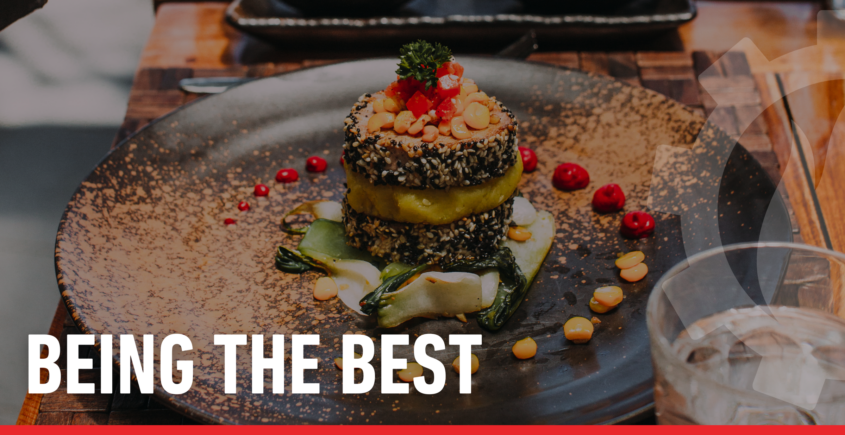Being the Best at What You Do
One of the goals we strive for here at KHT is to be the “best” at what we do. Whether it’s working together to solve your PIA (Pain in the @%$) Jobs!, providing great customer service, consistently delivering on time and on budget, or just being a bright spot in your day, we all work to be great. As the chief here, I love to walk the shop floor and recognize my gang for excellence, beyond just perfect parts, it’s the attitude and joy that comes from working together and pleasing our valued customers. When I was a kid, I remember my teacher used to give us gold stars next to our names on a chart that hung behind the classroom door (maybe I should try this!). The only problem would be I’d run out of stars – yes, my team is that good! For now, I’ll stick with acknowledging great work and service when I see it. It got me thinking about awards that other industries use, namely the Michelin Star Award for food and restaurant excellence. Like I love to do, especially with food! I did some digging and found cool info on the history and process of “getting a star” – for some, it’s the culmination of relentless perfection…for others, perhaps a curse in letting their secret out. Enjoy. And if you see us hitting it out of the park, send me a “star” I can share with my folks.

The Michelin star is the pinnacle of recognition in the culinary world, symbolizing excellence, precision, and creativity. Originating from an unlikely source—a tire company—this prestigious award has shaped the landscape of fine dining for over a century.
The story of the Michelin star begins in 1900, when French brothers André and Édouard Michelin, founders of the Michelin tire company, sought to encourage automobile travel. They published the first Michelin Guide, a resource for motorists that included maps, mechanics, and, most notably, restaurant recommendations. The goal was simple: get more people on the road, increasing the demand for tires.
By 1926, the guide began awarding stars to exceptional restaurants, initially using a single-star system. In 1931, Michelin introduced a three-tiered ranking:
One star: A very good restaurant in its category
Two stars: Excellent cooking, worth a detour
Three stars: Exceptional cuisine, worth a special journey
The first Michelin stars were awarded to French establishments, setting the stage for France’s dominance in the fine dining world. The guide’s expansion beyond France began in the mid-20th century, reaching other parts of Europe, then eventually Asia, North America, and beyond.
One of the earliest and most legendary Michelin-starred restaurants is La Maison Troisgros in France, which has held three stars since 1968—one of the longest streaks in Michelin history. Another noteworthy establishment is Paul Bocuse’s L’Auberge du Pont de Collonges, which held three stars for 55 consecutive years until 2020.
Michelin inspectors remain anonymous, dining at restaurants unannounced and paying their own way. They evaluate based on five main criteria: Quality of ingredients, Mastery of cooking techniques, Harmony of flavors, Personality of the chef in the cuisine, and Consistency across visits. Unlike other awards that factor in ambiance or service, Michelin focuses strictly on food quality. Inspectors dine multiple times before making a decision, ensuring consistency before awarding or removing a star. (I really want this job!)
The Michelin Guide has been around for over 120 years, growing from a French road companion to a global culinary authority. It is now published annually in different editions covering various regions, including France, Italy, Spain, Japan, the United States, and more. Each regional edition highlights the best restaurants within a particular area, reflecting local culinary traditions and emerging trends.
The guide is organized by country and major cities, offering insights into fine dining, casual eateries, and emerging food scenes. Apart from awarding stars, the guide also includes helpful tips for travelers, recommendations for affordable dining (Bib Gourmand), and recognition of sustainable practices (Green Star).
The Michelin Curse: Some chefs feel immense pressure to maintain their stars, with a few even returning them to reduce stress. In 2019, Sébastien Bras voluntarily relinquished his three-star status.
The First Three-Star Rating Outside France: The first non-French restaurant to receive three stars was Schweizer Stuben in Germany in 1974.
Michelin and Japan: Despite being a French award, Japan now has more Michelin-starred restaurants than any other country, with Tokyo leading as the city with the most stars. Factors for success include the exceptional quality of fresh ingredients, the meticulous attention to detail and perfectionism of Japanese chefs, a deep-rooted food culture that values seasonality and presentation, and a large and diverse culinary scene, Japanese cuisine’s emphasis on umami (savory taste) that adds depth and complexity to dishes.
Gordon Ramsay’s Emotional Moment: When his New York restaurant lost its two stars in 2013, the celebrity chef compared the feeling to “losing a girlfriend.”
From its humble beginnings as a tire company’s marketing tool to becoming the gold standard in fine dining, the Michelin Guide has dramatically influenced the culinary world. Whether inspiring young chefs, shaping restaurant prestige, or fueling culinary tourism, the Michelin star remains an enduring symbol of gastronomic excellence.
Here’s a link to the USA Michelin Guide Enjoy, and take me with you!






Leave a Reply
Want to join the discussion?Feel free to contribute!